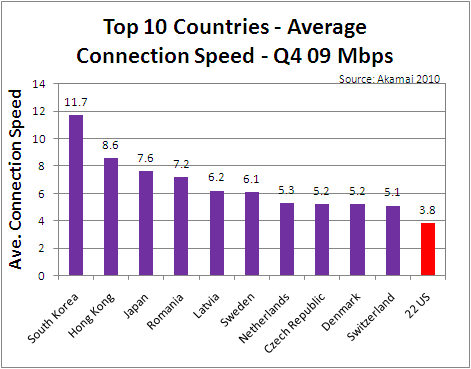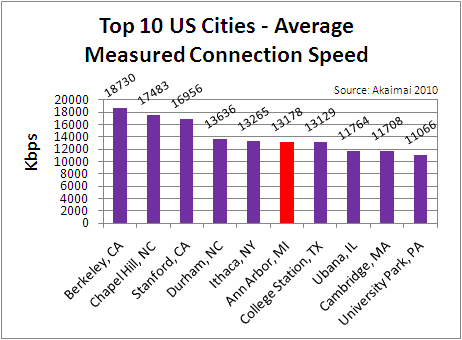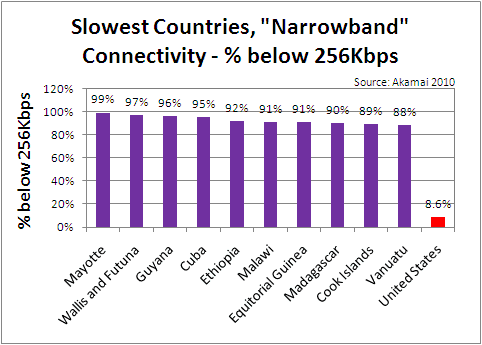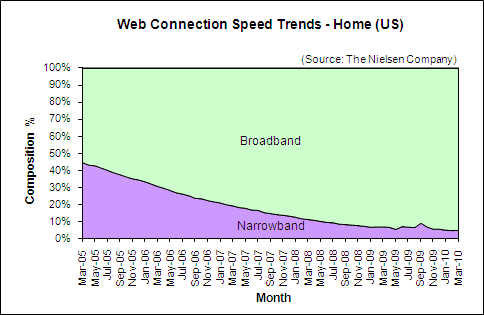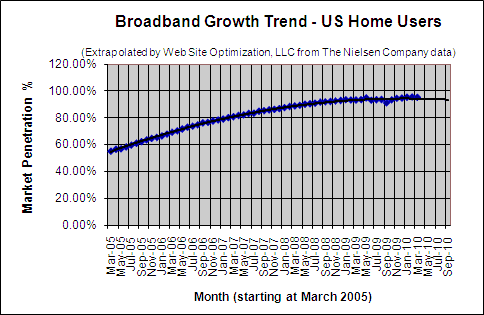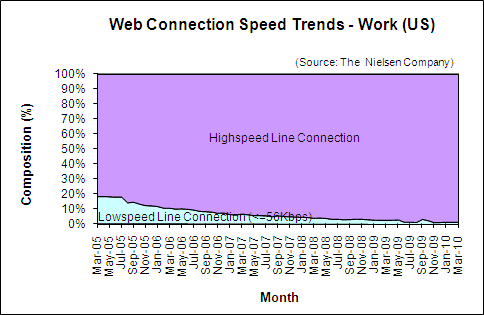The US dropped to 22nd place in broadband connection speed worldwide in a recent study by Akamai. The fastest broadband cities in the US are college towns, according to the same study. The top 10 US cities averaged four times faster than the average US broadband speed of 3.8Mbps. Meanwhile broadband penetration among active Internet users dropped to 95.17% in March 2010.
Fastest Broadband Countries
South Korea led all countries surveyed with an average connection speed of 11.7 Mbps, down 24% from the previous quarter (see Figure 1). Akamai reasons that the spread of the iPhone is dropping average connection speeds. Hong Kong came in second worldwide at 8.6Mbps average connection speed, followed by Japan at 7.6 Mbps, with Romania (7.2Mbps), and Latvia (6.2Mbps) rounding out the top five. The US dropped from 18th to 22nd place in average connection speed during the last quarter of 2009, averaging 3.8Mbps in connection speed, down 2.5% from the previous quarter (3.9Mbps).
Figure 1: Top 10 Countries, Average Measured Connection Speed
Source: Akamai
Fastest Broadband Cities are College Towns
The top ten US cities in broadband speed are dominated by college towns, according the Q4 2009 “State of the Internet” survey by Akamai (see Figure 2). Berkeley, California tops the list at 18,730 Kbps, followed by Chapel Hill, North Carolina at 17,483 Kbps. Stanford, California came in third at 16,856 Kbps, followed by Durham, NC at 13,636 Kbps, Ithaca, NY at 13,265 Kbps, and Ann Arbor, Michigan came in sixth overall at 13,178 Kbps. The top 10 cities for broadband speed average about 4 times the US average broadband speed of 3.8Mbps.
Figure 2: Top 10 US Cities, Average Measured Connection Speed
Source: Akamai
Slowest Broadband Counties
At the other end of the spectrum, Akamai measured which countries had the most “narrowband” connections below 256Kbps.
Mayotte topped the list with 99% of the population on connections of 256Kbps or less, averaging 40Kbps (see Figure 3). Wallis and Futuna came in second at 97% on narrowband, followed by Guyana at 96%, Cuba at 95%, and Ethiopia at 92%. In comparison the US had 8.6% of the population on narrowband connections, up 84% over the last quarter. Akamai attributes this increase in slower connections to the spread of mobile devices.
Figure 3: Slowest Countries Narrowband Speeds of 256Kbps or Less
Source: Akamai
Home Connectivity in the US
US broadband penetration dropped to 95.17% among active Internet users in March 2010. Dial-up users connecting at
56Kbps or less now make up 4.83% of active Internet users (see Figure 4).
Figure 4: Web Connection Speed Trends – Home Users (US)
Source: Nielsen
Broadband Growth Trends in the US
In March 2010, broadband penetration among active Internet users in US homes dropped to 95.17%, down 0.16
percentage points fron 95.33% in February (see Figure 5).
Work Connectivity
As of March 2010, 98.53% of US workers connected to the Internet with broadband, down 0.04 percentage points
from 98.57% in February 2010. Only 1.47% still connect at 56Kbps or less from work (see Figure 6).
Figure 6: Web Connection Speed Trends – Work Users (US)
Source: Nielsen

